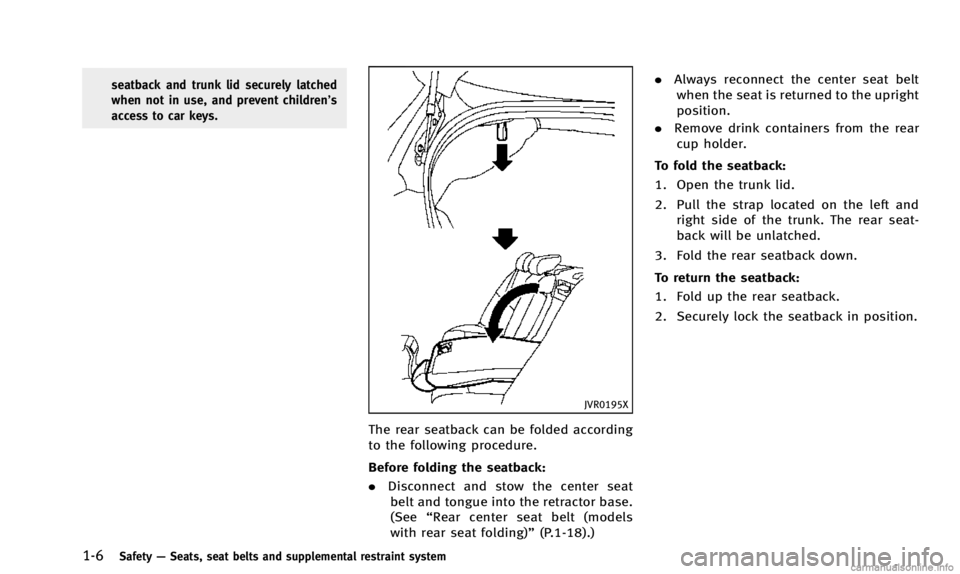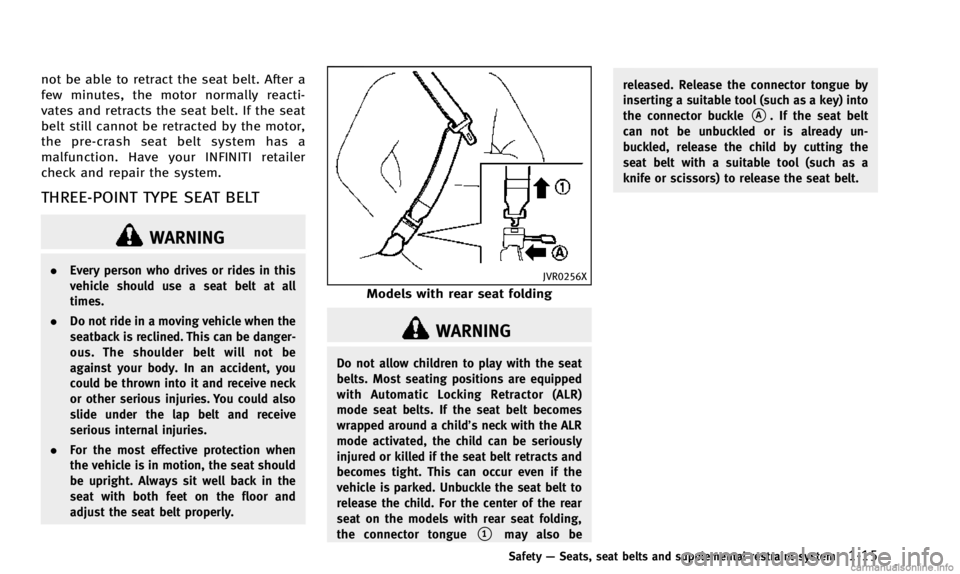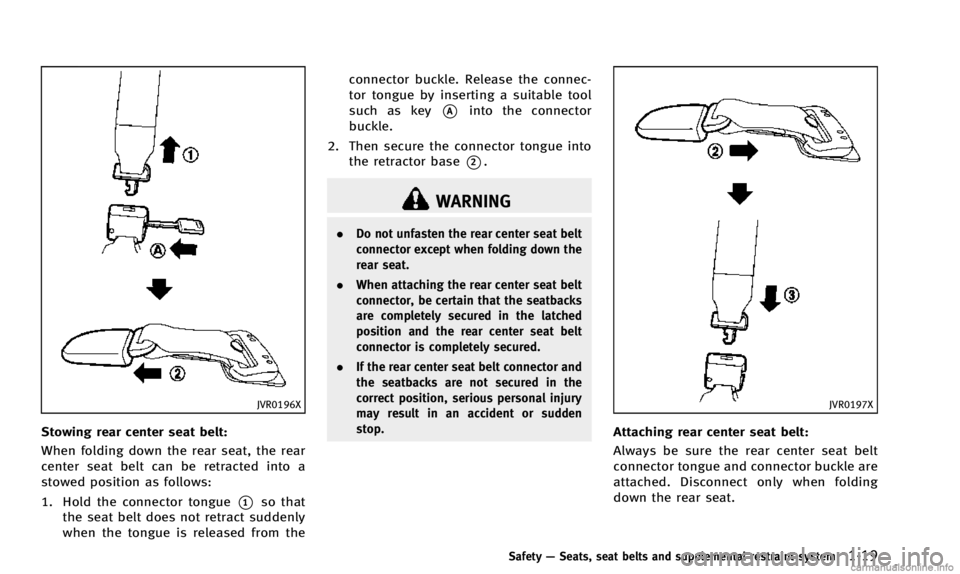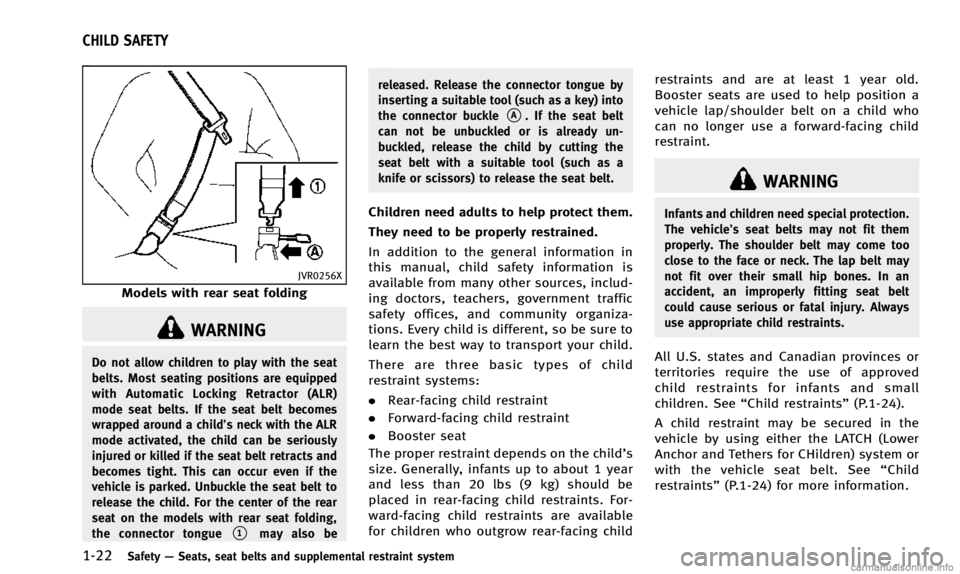key INFINITI Q50 2014 Owner's Manual
[x] Cancel search | Manufacturer: INFINITI, Model Year: 2014, Model line: Q50, Model: INFINITI Q50 2014Pages: 394, PDF Size: 1.99 MB
Page 10 of 394

JVC0438X
1. Hood (P.3-18)
2. Windshield wiper and washer—Operation (P.2-33)
— Maintenance (P.8-20)
3. Headlight —Operation (P.2-36) —
Adaptive Front lighting System
(AFS) (if so equipped) (P.2-41)
4. Moonroof (if so equipped) (P.2-51)
5. Power windows (P.2-49)
6. Outside mirrors (P.3-27) —Side turn signal lights (P.2-42) —
Side view camera (if so equipped)*
7. Recovery hook (P.6-16)
8. Sonar system (if so equipped)*
9. Front camera (if so equipped)*
10. Turn signal —Operation (P.2-36)
11. Fog light (P.2-42)
12. Tires —Wheels and tires (P.8-29, P.9-9)
— Flat tire (P.6-3)
— Tire Pressure Monitoring System
(TPMS) (P.2-14, P.5-4)
13. Doors —Keys (P.3-2)
— Door locks (P.3-4)
— Intelligent Key system (P.3-6)
— Remote keyless entry system
(P.3-14)
— Courtesy light (P.2-56)
*: Refer to the Infiniti InTouch Owner’s Manual.
Illustrated table of contents0-3
EXTERIOR FRONT
Page 11 of 394

0-4Illustrated table of contents
JVC0439X
1. Trunk—Intelligent Key system (P.3-6)
— Remote keyless entry system
(P.3-14)
— Trunk lid (P.3-19)
2. High-mounted stop light (P.8-26) 3. Satellite antenna (P.4-3)
4. Rear window defroster (P.2-36)/Anten-
na (P.4-3)
5. Sonar system (if so equipped)* —Back-up Collision Intervention (BCI)
system (if so equipped) (P.5-48) 6. Rear view camera*
7. Recovery hook (P.6-16)
8. Rear combination light (P.8-26)
9. Fuel-filler door
—Operation (P.3-21)
— Fuel information (P.9-4)
10. Child safety rear door locks (P.3-6)
*: Refer to the Infiniti InTouch Owner’s Manual.
EXTERIOR REAR
Page 25 of 394

1-6Safety—Seats, seat belts and supplemental restraint system
seatback and trunk lid securely latched
when not in use, and prevent children’s
access to car keys.
JVR0195X
The rear seatback can be folded according
to the following procedure.
Before folding the seatback:
. Disconnect and stow the center seat
belt and tongue into the retractor base.
(See “Rear center seat belt (models
with rear seat folding)” (P.1-18).).
Always reconnect the center seat belt
when the seat is returned to the upright
position.
. Remove drink containers from the rear
cup holder.
To fold the seatback:
1. Open the trunk lid.
2. Pull the strap located on the left and right side of the trunk. The rear seat-
back will be unlatched.
3. Fold the rear seatback down.
To return the seatback:
1. Fold up the rear seatback.
2. Securely lock the seatback in position.
Page 26 of 394

SSS1061
ARMREST
Rear armrest
Pull the armrest forward until it is hor-
izontal.
JVR0187X
Trunk pass-through
The rear center seatback can be folded to
allow trunk access from inside of the
vehicle.
To access the trunk, pull down the rear
center armrest and pull out the trunk pass-
through lid
*1.
To lock the lid, use the mechanical key and
turn it to the LOCK position
*2. To unlock,
turn the mechanical key to the UNLOCK
position
*3. For the mechanical key usage,
see “Keys” (P.3-2).
Make sure that the mechanical key is
removed from the trunk pass-through lid key cylinder before opening or closing the
lid. Otherwise the lid and the rear armrest
may be damaged.
Safety
—Seats, seat belts and supplemental restraint system1-7
Page 34 of 394

not be able to retract the seat belt. After a
few minutes, the motor normally reacti-
vates and retracts the seat belt. If the seat
belt still cannot be retracted by the motor,
the pre-crash seat belt system has a
malfunction. Have your INFINITI retailer
check and repair the system.
THREE-POINT TYPE SEAT BELT
WARNING
.Every person who drives or rides in this
vehicle should use a seat belt at all
times.
. Do not ride in a moving vehicle when the
seatback is reclined. This can be danger-
ous. The shoulder belt will not be
against your body. In an accident, you
could be thrown into it and receive neck
or other serious injuries. You could also
slide under the lap belt and receive
serious internal injuries.
. For the most effective protection when
the vehicle is in motion, the seat should
be upright. Always sit well back in the
seat with both feet on the floor and
adjust the seat belt properly.JVR0256X
Models with rear seat folding
WARNING
Do not allow children to play with the seat
belts. Most seating positions are equipped
with Automatic Locking Retractor (ALR)
mode seat belts. If the seat belt becomes
wrapped around a child’s neck with the ALR
mode activated, the child can be seriously
injured or killed if the seat belt retracts and
becomes tight. This can occur even if the
vehicle is parked. Unbuckle the seat belt to
release the child. For the center of the rear
seat on the models with rear seat folding,
the connector tongue
*1may also be released. Release the connector tongue by
inserting a suitable tool (such as a key) into
the connector buckle
*A. If the seat belt
can not be unbuckled or is already un-
buckled, release the child by cutting the
seat belt with a suitable tool (such as a
knife or scissors) to release the seat belt.
Safety —Seats, seat belts and supplemental restraint system1-15
Page 38 of 394

JVR0196X
Stowing rear center seat belt:
When folding down the rear seat, the rear
center seat belt can be retracted into a
stowed position as follows:
1. Hold the connector tongue
*1so that
the seat belt does not retract suddenly
when the tongue is released from the connector buckle. Release the connec-
tor tongue by inserting a suitable tool
such as key
*Ainto the connector
buckle.
2. Then secure the connector tongue into the retractor base
*2.
WARNING
. Do not unfasten the rear center seat belt
connector except when folding down the
rear seat.
. When attaching the rear center seat belt
connector, be certain that the seatbacks
are completely secured in the latched
position and the rear center seat belt
connector is completely secured.
. If the rear center seat belt connector and
the seatbacks are not secured in the
correct position, serious personal injury
may result in an accident or sudden
stop.
JVR0197X
Attaching rear center seat belt:
Always be sure the rear center seat belt
connector tongue and connector buckle are
attached. Disconnect only when folding
down the rear seat.
Safety —Seats, seat belts and supplemental restraint system1-19
Page 41 of 394

1-22Safety—Seats, seat belts and supplemental restraint system
JVR0256X
Models with rear seat folding
WARNING
Do not allow children to play with the seat
belts. Most seating positions are equipped
with Automatic Locking Retractor (ALR)
mode seat belts. If the seat belt becomes
wrapped around a child’s neck with the ALR
mode activated, the child can be seriously
injured or killed if the seat belt retracts and
becomes tight. This can occur even if the
vehicle is parked. Unbuckle the seat belt to
release the child. For the center of the rear
seat on the models with rear seat folding,
the connector tongue
*1may also be released. Release the connector tongue by
inserting a suitable tool (such as a key) into
the connector buckle
*A. If the seat belt
can not be unbuckled or is already un-
buckled, release the child by cutting the
seat belt with a suitable tool (such as a
knife or scissors) to release the seat belt.
Children need adults to help protect them.
They need to be properly restrained.
In addition to the general information in
this manual, child safety information is
available from many other sources, includ-
ing doctors, teachers, government traffic
safety offices, and community organiza-
tions. Every child is different, so be sure to
learn the best way to transport your child.
There are three basic types of child
restraint systems:
. Rear-facing child restraint
. Forward-facing child restraint
. Booster seat
The proper restraint depends on the child ’s
size. Generally, infants up to about 1 year
and less than 20 lbs (9 kg) should be
placed in rear-facing child restraints. For-
ward-facing child restraints are available
for children who outgrow rear-facing child restraints and are at least 1 year old.
Booster seats are used to help position a
vehicle lap/shoulder belt on a child who
can no longer use a forward-facing child
restraint.
WARNING
Infants and children need special protection.
The vehicle’s seat belts may not fit them
properly. The shoulder belt may come too
close to the face or neck. The lap belt may
not fit over their small hip bones. In an
accident, an improperly fitting seat belt
could cause serious or fatal injury. Always
use appropriate child restraints.
All U.S. states and Canadian provinces or
territories require the use of approved
child restraints for infants and small
children. See
“Child restraints” (P.1-24).
A child restraint may be secured in the
vehicle by using either the LATCH (Lower
Anchor and Tethers for CHildren) system or
with the vehicle seat belt. See “Child
restraints” (P.1-24) for more information.
CHILD SAFETY
Page 93 of 394

2-16Instruments and controls
Master warning light
When the ignition switch is in the ON
position, the master warning light illumi-
nates if any of the following warnings
appear in the vehicle information display:
.No key warning
. PUSH warning
. Key ID Incorrect warning
. Low washer fluid warning
. Door/trunk open warning
. Loose fuel cap warning
. Tire Pressure Low - Add Air warning
. Flat Tire - Visit dealer warning
. All-Wheel Drive (AWD) warning (if so
equipped)
. Headlight warning
. Adaptive Front lighting System (AFS)
warning (if so equipped)
. Intelligent Key system warning
. Chassis control warning
See “Vehicle information display” (P.2-20).
If the driver assist system warnings appear
in the vehicle information display, the
master warning light also illuminates. See
“Lane Departure Warning (LDW) system/
Lane Departure Prevention (LDP) system”
(P.5-30), “Blind Spot Warning/Blind Spot Intervention
TM/Back-up Collision Interven-
tion systems” (P.5-37),“Distance Control
Assist (DCA) system” (P.5-79),“Forward
emergency braking system” (P.5-89) and
“Predictive forward collision warning sys-
tem” (P.5-94).
Power steering warning light
(if so equipped)
When the ignition switch is in the ON
position, the power steering warning light
illuminates. After starting the engine, the
power steering warning light turns off. This
indicates that Direct Adaptive Steering is
operational.
If the power steering warning light illumi-
nates while the engine is running, it may
indicate Direct Adaptive Steering is not
functioning properly and may need servi-
cing. Have Direct Adaptive Steering
checked by an INFINITI retailer. (See “Direct
Adaptive Steering type” (P.5-104).)
Seat belt warning light and
chime
The light and chime remind you to fasten
seat belts. The light illuminates whenever
the ignition switch is pushed to the ON
position, and will remain illuminated until the driver’s seat belt is fastened. At the
same time, the chime will sound for about
6 seconds unless the driver’s seat belt is
securely fastened.
The seat belt warning light for the front
passenger will illuminate if the seat belt is
not fastened when the front passenger’s
seat is occupied.
See
“Seat belts” (P.1-12) for precautions
on seat belt usage.
Supplemental air bag warning
light
After pushing the ignition switch to the ON
position, the supplemental air bag warning
light will illuminate. The supplemental air
bag warning light will turn off after about 7
seconds if the supplemental front air bag
and supplemental side air bag, curtain
side-impact air bag systems and/or pre-
tensioner seat belt are operational.
If any of the following conditions occur, the
supplemental front air bag, supplemental
side air bag, supplemental curtain side-
impact air bag and pretensioner seat belt
needs servicing and your vehicle must be
taken to your nearest INFINITI retailer.
. The supplemental air bag warning light
remains on after approximately 7 sec-
Page 96 of 394

Security indicator light
The light blinks when the ignition switch is
in the ACC, OFF or LOCK position. This
function indicates the security system
equipped on the vehicle is operational.
If the security system is malfunctioning,
this light will remain on while the ignition
switch is in the ON position. For additional
information, see“Security systems” (P.2-
30).
Turn signal/hazard indicator
lights
The light flashes when the turn signal
switch lever or hazard switch is turned on.
Vehicle Dynamic Control (VDC)
off indicator light
The light comes on when the Vehicle
Dynamic Control (VDC) off switch is pushed
to OFF. This indicates that the VDC system
and traction control system are not operat-
ing.
AUDIBLE REMINDERS
Key reminder chime
A chime will sound if the driver side door is
opened while the ignition switch is pushed
to the ACC position. Make sure the ignition
switch is pushed to the OFF position, and
take the Intelligent Key with you when
leaving the vehicle.
Light reminder chime
A chime will sound when the driver side
door is opened with the light switch in the
orposition and the ignition switch
in the ACC, OFF or LOCK position.
Turn the light switch off when you leave the
vehicle.
Parking brake reminder chime
The parking brake reminder chime will
sound if the vehicle is driven at more than
4 MPH (7 km/h) with the parking brake
applied. Stop the vehicle and release the
parking brake.
Brake pad wear warning
The disc brake pads have audible wear
warnings. When a brake pad requires
replacement, it will make a high pitched
scraping sound when the vehicle is in motion. This scraping sound will first occur
only when the brake pedal is depressed.
After more wear of the brake pad, the
sound will always be heard even if the
brake pedal is not depressed. Have the
brakes checked as soon as possible if the
warning sound is heard.
Instruments and controls2-19
Page 97 of 394

2-20Instruments and controls
JVI0641X
The vehicle information display*1is
located between the tachometer and the
speedometer, and it displays the warnings
and information. The following items are
also displayed if the vehicle is equipped
with them:
. Automatic Transmission (AT)
—“ Driving the vehicle” (P.5-15)
. All-Wheel Drive (AWD)
—“ Intelligent All-Wheel Drive (AWD)”
(P.5-101)
. Cruise control
—“ Cruise control” (P.5-56) .
Intelligent Cruise Control (ICC)
—“ Intelligent Cruise Control (ICC) sys-
tem” (P.5-58)
. Active Lane Control
—“ Active Lane Control” (P.5-24)
. Lane Departure Warning (LDW)/Lane
Departure Prevention (LDP) system
—“ Lane Departure Warning (LDW) sys-
tem/Lane Departure Prevention
(LDP) system” (P.5-30)
. Blind Spot Warning (BSW)/Blind Spot
Intervention
TM(BSI)/Back-up Collision
Intervention (BCI) systems
—“ Blind Spot Warning/Blind Spot
Intervention
TM/Back-up Collision In-
tervention systems” (P.5-37)
. Distance Control Assist (DCA) system
—“ Distance Control Assist (DCA) sys-
tem” (P.5-79)
. Forward emergency braking system
—“ Forward emergency braking sys-
tem” (P.5-89)
. Predictive forward collision warning
system
—“ Predictive forward collision warn-
ing system” (P.5-94)
. Active trace control —“
Active trace control” (P.5-110)
. Intelligent Key system
—“ Intelligent Key system” (P.3-6)
VEHICLE INFORMATION DISPLAY